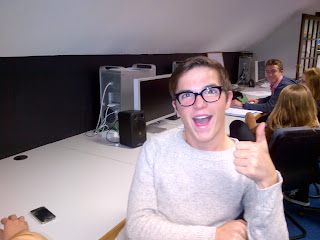Editing can be a tricky process. We walked into the editing suite with confident smiles on our faces, only to be met with an unloving blank stare from the computer monitors.
After all our clips were uploaded onto the server, we sat down, selected our folder and checked it in. Now we were ready to begin the true editing process. Naturally, the first thing we did was to create a Rush bin, and move all the clips into there, and put a Log bin above for the clips we might be using. Since we were quite an indecisive team, we created a Maybe bin, for clips where the audio was useful or if the visual was more useful.
 |
| We put our log, rush and maybe bins in the browser after checking them in the viewer. We then put them together on the timeline and watched the finished product in the canvas. |
Preceding the creation of the bins and watching/sorting the clips, we began dragging the best clips we had into order, into a sort of rough draft. This took a couple of sessions.
The way we organised the actual editing was to have one person controlling the computer, while the other two would just contribute to how we should cut it or what order it should go in. We had external people watch the clip to confirm its verisimilitude and to let us know if we succeed in creating interest.
After we had set up the main chronological order and cut down the clips, we saved it to one computer, taking it off the Final Cut Server, and put it into High Definition. This gave us a completely new perspective on how we would add in special effects for the flashbacks, as well as how fluid it was so far.
The main thing we worked on during the process, after we had put everything into order and cut it down was the special effects for the flashbacks and the sound.
 For the flashbacks, we used the filter "Bad Film" and sped up the clips to create a shaky effect. This really helped differentiate between the flashbacks and the main clips, as well as adding a creepier atmosphere to it and creating the enigma of the film. We also added shatter sounds during the flashbacks from Soundtrack Pro to further differentiate them from the rest of the clip.
For the flashbacks, we used the filter "Bad Film" and sped up the clips to create a shaky effect. This really helped differentiate between the flashbacks and the main clips, as well as adding a creepier atmosphere to it and creating the enigma of the film. We also added shatter sounds during the flashbacks from Soundtrack Pro to further differentiate them from the rest of the clip. 
The sound was what took up the majority of our time in editing. We had to cut different sounds to create the effect we wanted, meaning we had to split many of the audio tracks from their video clips to move them around, which proved quite confusing. We elongated the sounds of one of the car clips to cover the entire car scene because it was the best out of them all, continuing it to the text "Zirgi" as the detective slammed the second door, it created fluidity in editing. We also auditioned sounds from Soundtrack Pro for the wind ambient sounds, to create a remote, wintry Eastern European setting. We put these sounds throughout the thriller and put reverb on them to create an atmosphere that one might find inside a shipping container, metallic and cold.
An important contribution that I made to the editing process was cropping the frame of the clip to cover up some mistakes that our actors made when the detective (Simon) was looking at the handprint. I did this by resizing it and increasing the definition of the newly cropped clip. This took me about 20 minutes to figure out, but it made a big difference to the visual appeal of our film as well as keeping the verisimilitude of it.




No comments:
Post a Comment